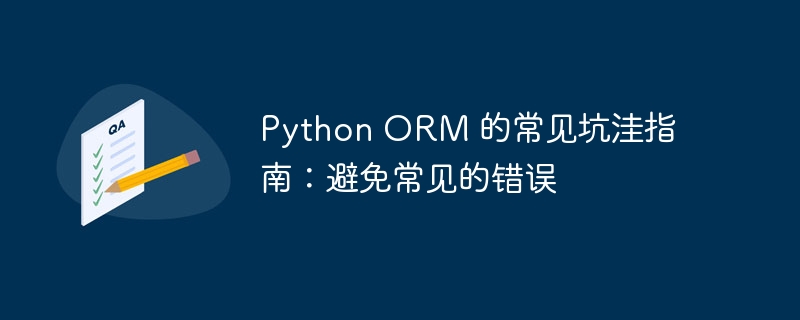
Python ORM Guide to Common Potholes: Avoid Common Mistakes
Connection pool problem:
-
Improper connection pool creation: Ensure that a connection pool is created and managed for the application to avoid the overhead of establishing and closing connections to the database server .
-
Improperly sized connection pool: The connection pool should be large enough to meet the needs of the application, but not so large that it wastes resources.
-
Connection pool timeout problem: Set a reasonable connection pool timeout value to avoid connection failure due to long-term unused.
Query optimization:
-
N 1 Query: When using ORM to traverse query results, avoid making additional database queries to obtain related objects.
-
eager loading: Use the ORM's
eager_loading option to obtain the associated object at once to reduce the number of database queries.
-
Use indexes correctly: Make sure you have appropriate indexes on your database tables to improve query performance.
Transaction Management:
-
Forgot to commit the transaction: Explicitly commit the transaction to ensure that the database operation is executed successfully.
-
Nested transactions: Avoid nesting other transactions within a transaction, which can lead to complexity and errors.
-
Optimistic concurrency control: Use ORM’s optimistic Concurrency control mechanism to handle concurrent transactions and data conflicts.
Migration issues:
-
Improper migration management: Use the ORM's migration feature to manage database schema changes to avoid data loss or corruption.
-
Delete columns early: Remove a table column from the ORM model before deleting it to avoid data integrity issues.
-
Foreign key constraints: Make sure to create foreign key constraints to maintain relationships between tables to prevent data inconsistencies.
Performance issues:
-
Object state tracking: ORM tracks the state of objects, which may have an impact on performance. Only keep track of necessary objects and clean out unused objects regularly.
-
Lazy loading: Use the lazy loading option reasonably to reduce unnecessary database queries.
-
Prefetch: Prefetch associated objects when needed to reduce N 1 queries.
Security Question:
-
SQL injection: Use the parameterized query function of the ORM to prevent sql injection attacks.
-
Data Breaches: Ensure access permissions are configured correctly to prevent unauthorized data access.
-
Cross-site scripting attacks (XSS): Use the ORM's escaping mechanism to filter user input to prevent XSS attacks.
Other notes:
-
Version Compatibility: Make sure the ORM version is compatible with the python version and database backend.
-
Insufficient documentation: Read the ORM documentation carefully to fully understand its features and limitations.
-
Monitoring and Debugging: RegularlyMonitor ORM performance and enable debugging logging to quickly identify and resolve issues.
The above is the detailed content of A Guide to Common Potholes in Python ORM: Avoid Common Mistakes. For more information, please follow other related articles on the PHP Chinese website!






